Craig's Stereography
Last worked on: March 12th, 2019
You're at: https://craigeroochi.neocities.org/stereo.htm
To enlarge the fonts, click: "Ctrl" and "+" ("Ctrl"
and "0" for normal).
I no longer do stereography commercially.

Find>> How
to turn Fuji-W3 camera images into stereo prints: step-by-step - The
W3 camera
- Our
old 5 inch card viewers & Sets of Viewcards
- Working with available cameras, Fuji's W3
and digital processors -
T-Plate
Mounting Steps - Open Mounting
Steps - Glossary - Addresses
- Accessory Lenses for Nimslo - Bifold
format -
Print Stereo Film - StereoSynthesis
- Chicago - 6x13 - The RWVer
and Standard Holmes/Bates format Stereoscopes
-
My past Stereo Services - Freeviewing
- Tutorials: trimming & mounting - sample
view - Join NSA &
SSA - Modern times -
-
~~~~~~~~~~~~~~~~~~~
-
3/12/2019 updates: * As will be the
case for all of my 50+ pages, I'm boosting the font sizes throughout --for
today's high resolution displays.
-
-
* My how-to pages for making print pair
stereographs began with steps based on having a photographic darkroom,
a trimming jig and a razor knife (back in the early 1980s) and ran through
digital methods, including processing steps using the (free) Stereo Photo
Maker application and a desktop printer --which assumes you've made an
investment in buying one, plus a computer and a decent monitor. Since I'm
surely out of date now on all of that --plus hand cameras of any kind are
disappearing (plenty of good ones at your local Goodwill, however!), I'm
only going to organize those old pages (cleaning up my links to them):
-
-
~
-
-
~
-
-
~
-
-
~
-
-
~
-
-
--then confine myself to what I know: how
I make stereo views --using generic digital image
pairs, simple graphics programs and cheap/good printers.
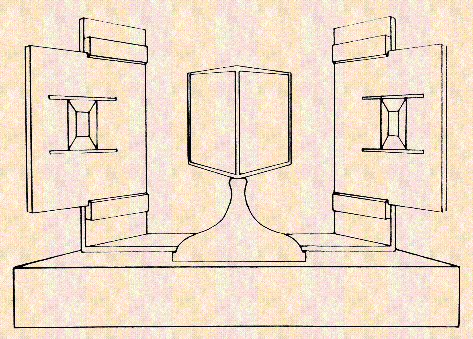
* Wheatstone's stereoscope was a bulky affair
with mirrors that sat on a table.
Stereoscopy is older than photography --by about 6
months, so inventor Sir Charles Wheatstone had to draw the first viewcards
by hand(!) in 1838. It was Wheatstone who coined the term "stereoscope"
--at his presentation to the Royal Society (of London --the oldest national
scientific society in the world), and (amazingly) he was the first person
to put two and two together in order to create a stereoscopic print
pair. The Renaissance artists, such as Leonardo da Vinci, were very aware
that binocular vision allows of depth perception, and there's indications
for such awareness among Greek philosophers. (Corrections here thanks to
reading Carol Jacobi and Dr. Brian May.)
* Next came Sir David Brewster's much smaller box stereoscope--

--suitable for passing around in a social circle.
Finally, in 1861, came a lightweight, open, skeletal
stereoscope, as a rude version of--

--the ones we're now using.
This modern era 'scope was designed by Dr. Oliver Wendell
Holmes (Senior --father of Supreme Court Justice Holmes) and jointly developed
with his craftsman friend: Joseph L. Bates. Holmes, who did much to popularize
stereography, chose not to encumber his invention with patents (bless him).
~ Until about 1930, commercial photographers
were usually also stereographers and millions of affordable Holmes-Bates
'scopes were manufactured. With the advent of inexpensive half-tone mechanical
image printing, what was originally a limited, upper middle class "parlor
stereoscope" experience, became a working class delight as well. Viewcards
ended up being given away as grocery store premiums.

-
My Work (2018b):
-
-
Some attractions of print pairs are simply due to their
being stereoscopic: a fascinating play of perspective, an ethereal feeling
of having "presence" in another time and place. There are subtleties
as well: a graceful balance between a moment of life on the front of the
card and its interpretation on the verso, a felt connection with the subject
and the stereographer.
-
-
The view card (or "folder") in your hand is a mixed medium
with power, reach, and an inherent poetry. Print pair stereography
is an art form to contend with, worthy of both lighthearted and serious
practice.
-
-
With these strengths, print pair views do well as a humble
witness to life. Simply match appealing images with well edited thoughts
on worthwhile subjects. The medium itself carries my ordinary efforts
with its engaging illusion and recognition of life. Each card completion
becomes a self-documented cultural artifact, registration for a visual
delight or bit of history, and another portal to the Nature and human endeavors.
-
-
And as life rushes by, new images and mental abstractions
of old ones quickly displace the few visual experiences we even try to
focus on --like the press of so many curiosity seekers gathering to the
scene of a happening. But in the view card's stillness, we can find
the personal time to clearly see and "take in" --perhaps a detail made
visible only through stereography, the seeming reality of a scene otherwise
lost to living eyes, --a face: still fresh and earnest in the warm light
of a distant summer.
-
Craig

Modern Times Stereographica:
* The most interesting development has been the adaptation
of Android and Apple smart phones' tall displays to (turned sidewise) a
pair of stereoscopic/3D, "virtual reality" images --using head mounted
devices like this one:
 --which are appearing in electronics departments across
the U.S. On the near horizon are VR versions like the Oculus system with
"four times higher resolution than todayís 4K TVs".
--which are appearing in electronics departments across
the U.S. On the near horizon are VR versions like the Oculus system with
"four times higher resolution than todayís 4K TVs".
The most outrageously low priced offering I've seen
of late: an RC drone model helicopter with a camera and WiFi "virtual reality"
capability (to your smart phone) for $28.88 --at a local department store.
(Gawd: that has to leave something to be desired.)
Presumably: when you access a website with VR content,
gyro/compass sensors and even co-ordinated GPS utilities in your smart
phone --interact with the image pair and a downloaded application --for
a just-turn-your-head, near 360 degree experience.
* To appreciate --at least the potential capabilities
of an integrated VR experience, Google up the You Tube presentation of
PBS-Nova's installment: "Invisible
Cities".
This is something quite other --than the "moment in
time" virtual reality of a traditional stereoscope, and it's becoming a
complete system, now that affordably priced cameras are arriving on the
scene --per:
The "JEDEye":
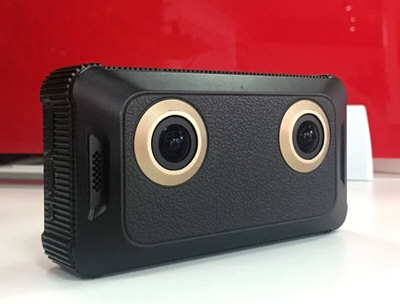 --and the 180 degree "LucidCam":
--and the 180 degree "LucidCam":

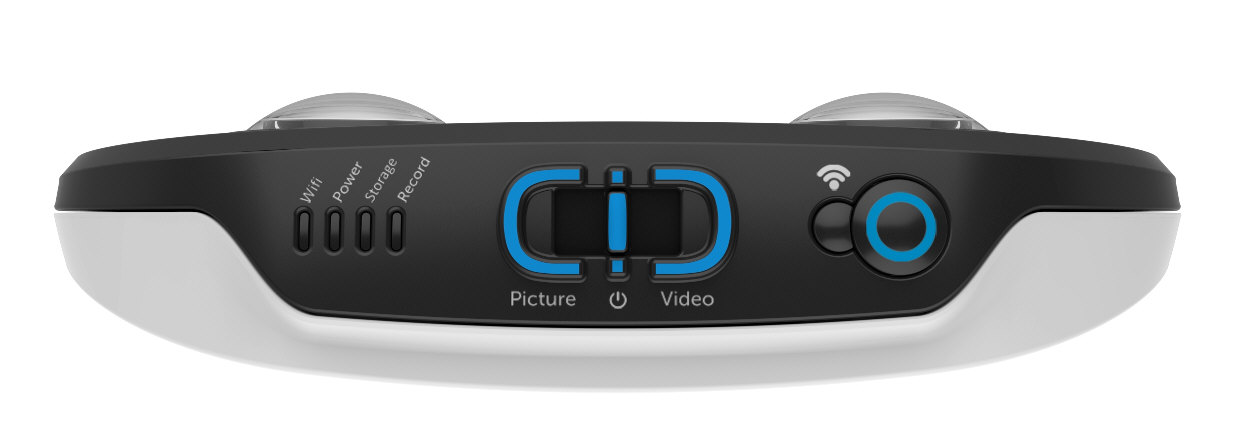
* By looking at the video presentations, it seems that
the associated applications for these cameras (which download to your smart
phone and might require some manual setup) --allow for some panning of
the available wide image, by turning your head --thus: "immersive virtual
reality". Caveat emptor: I expect that these systems will initially be
very "patchy".
* (Read on for older, DIY 3D camera options.)

Popular and serious stereography got a tremendous
boost with the introduction of Fujifilm's delightful model W1 and W3 cameras.
This modern, durable, well thought out and affordable instrument, set on
automatic, will reliably nail the exposure and color of nearly anything
it's aimed at. Unfortunately, inventories of its production run have sold
out and there (so far) doesn't appear to be a successor on the way. What
new and old options we still have for taking stereographic photos follows.
Here and here
is what I've already posted about the W3. (Note that the W3 has user feature
improvements but is otherwise very similar to the W1.)

What I see at Amazon.com (in no special order, but
leaving out video only, mobile phone accessories, and "Holga" class cameras):
* New and used W3 and W1 cameras at about twice the
old retail-new prices.
* A new (to me, anyway) 3D camera/camcorder entry from
Sony, but I'm not sure it's being officially sold in the USA. From reading
a poorly translated article, I see its emphasis is on automated flexibility
between 2D and 3D modes, has a respectable pair of sensors (5 megapixel)
and is capable of HD video. I've seen a new asking price of $395. This
is the
"Sony MobileHD Camera Bloggie 3D MHS-FS3".
* Something dubbed the model "DXG-018Y", which is clearly
a digital "box camera" with fixed focus lenses. My Amazon page save came
out badly, but I can make out that it has an LCD screen, color balance
options, extremely short focal length lenses ("2mm") and tiny sensors ("1/9
inch"), which capture "0.3" megapixel images --which must be close to a
standard definition video frame --which isn't enough resolution to print
a standard sized stereoscopic pair (3x3 inches each frame). Other than
that, the lone customer/reviewer is happy with his purchase (at $87.99).
It's supposed to have been sold through Amazon.com since 2011, but it's
new to me.
* The uninspiringly named "Takara Tomy 3d Shot Cam",
described at Amazon with lame English. It's only $47.47 and it ships for
free --straight from Japan. (In 2014, this same camera shipped free for
$26!) For $47.47 you don't get an LCD display and the image pair have amazingly
low resolution (about 150x200pixels, according to one reviewer). The lenses
are (of course) fixed focus --no doubt with amazing depth of field.
* Panasonic's "Lumix 3D1-K". This is a real, 12 megapixel
camera, being sold used at Amazon for $548.55, but I see a (once upon a
time: 2014) new price of $180, straight from Japan --so shop around. Looking
at it, this camera should be great for close-ups, interior and lawn party
shots, but might leave a bit to be desired when shooting scenics, since
the lenses look rather closely spaced (30mm apart). I read that everything
about it is in Japanese, but there's a downloadable manual in English.
~ The JVC "Everio Gs-td1" camera/camcorder --at about
$500 (and that's all I know at this point).
* The "Aiptek 3D-HD" camcorder/camera --has been around
since 2010, when it sold for $200, and can now be had for $129 --shipped
for free. With its 5 megapixel sensors, I can rate this "almost a real
camera". The image pairs I've worked with were quite decent. See my early
extensive reviews hear and
here
(and scroll up).
* Then there's Vivitar's "Vivicam 3D" entry: a 3D digital
camera for $29.99 at Amazon --shipped free, but you'd best read the reviews.
Be my guess: this was an abortive production run from some years ago, now
being dumped, and the internal lithium battery has pretty much expired.
(Again: read the buyer reviews.)

I've been wanting to make a statement about American
stereoscopic movies and how they drove a short lived revival of amateur
stereoscopy, but I lack depth in cinema --technically and culturally. Here
instead (and I hope it stays posted) is a thoughtful blog by veteran cinematographer
John Bailey, ASC., --who extends a deep bow to the research and publications
authored by the NSA's own Ray Zone (who died in 2012).
.
http://www.ascmag.com/blog/2010/06/28/3-d-3-d-3-d-in-all-directions/
.
My impression: Mr. Bailey is wary and a bit put-upon
(justifiably) that the hustle of profits and fashion driven innovation
--demands that he now confront (and probably integrate) stereoscopy into
his repertoire of expertise. (As a life-long technician, I'm deeply sympathetic.)
This technically and professionally competent man is just enough of a "3D"
outsider to have a valuable point of view --about his neck of the stereoscopic
woods.
.
"Working in stereo movies in a responsible way is
not simply a point and shoot affair, even under the simplest of conditions.
--- There is a dictate that became a mantra doled out by the workshop instructors
and taken to heart by we eager students: 3-D in movies is NOT REAL. Like
an Escher drawing, it is an illusion. Our actual eyes simply don't function
the way 3-D movie imagery does. In constructing the 3-D movie frame we
professional cinematographers have to evaluate carefully all the visual
elements contained within the shot, as well as their cumulative effect
as the sequence develops, shot by shot."
.
* Throughout this opinion piece, Mr. Bailey (and,
presumably, the instructor of a workshop in filming stereo movies that
he [then] recently attended) accepts it that the camera/s lenses will have
both interaxial (camera base) and convergence adjustment --or: "toe-in".
While this is a convenient way to deal with the stereo window, I hope that
better awareness and equipment (or creative control during the editing
stage) will one day make this a practice of the past. In the indeterminate
meanwhile, we'll have to rely on the cinematographer's good sense that
"something is wrong" --and he/she then backs off on the convergence --in
favor of reduced interaxial.
.
I also commend the comments section to your attention,
such as: "Among Avatarís innumerable failures, its stubborn refusal to
develop any kind of grammar^ (or even acknowledging that a new one was
required) was the one that angered me the most" (by Benoît Perrier).
Ray Zone also adds some thoughts about the inevitability of 3D cinema.
(^Standards of practice --and per my old beefs with the NSA and SSA.)
.
I've now reconsidered my first impressions of Avatar
--that it was the most competently executed Hollywood stereoscopic motion
picture I've seen, plus culturally/thematically friendly to me in that
it identified with the (idealized) victims of our sick, imperial, corporate
run nation. So I still give it "two thumbs up", --but yes: even the time
I first saw this movie, I would have preferred it (personally) if the stereoscopy
(interaxial/"deviation" content) had backed off a bit, and if the cuts
were longer. (Gosh: I felt like such an old man --gripping the arm rests
of my seat, but I realized that a younger audience was enjoying the ride.)
.
Avatar, good as it was, could have been more subtly
and aesthetically executed --but probably to the detriment of the boost
it gave our stereoscopic industries in general. Hopefully, venture capital
and patronage will support an ever maturing "grammar" of stereoscopic cinematography.
.
~~~~~~~~~~~~~~~~~~~

(use red-blue
3D glasses for the kitty)
StereoSynthesis
* On 8/6/2006 I discovered a coinage and trademark
use of "StereoSynthesis" that was previous to my own first use in 1993.
David M. Geshwind patented a process he called "Stereosynthesis" for converting
2D cine footage into 3D in 1990. I suspect that it wasn't the high resolution
"in the round" photo-realistic rendering I was doing in 1993, but it was
very advanced, fast, and digitally automated. By contrast, I painstakingly
plot out my sometimes pixel level manipulations by hand and then execute
my plan with a general purpose graphics program. I never applied for any
patents or trademark protection, but I did quite a bit of work through
my agent, James Curtin ("The Added Dimension"), during the 1990s.
-
It's fun to take a regular (non-stereoscopic) photo
and render it into a 3D image. Eventually, our "Tutorials"
section will supply the information you'll need to do this StereoSynthesis
on your own --skills that a number of stereoscopists have now mastered,
but (I gather) using different methods.
For commercial services in rendering 2D to 3D (especially
as lenticular displays), contact Peter Sinclair at:
* http://snap3d.com/
-
 -
-
"High resolution" in the early
90s was different from what's considered even adequate resolution today.
Back when 150 line screen on a 2540 dpi commercial press was considered
real quality, we used a shop with a row of million dollar Heidleburg presses
in Ohio to do our process color printing. (The finished images were
to be viewed with 4 to 7 inch focal length lenses.) When I proofed
the work, using a troublesome dye sublimation printer, I thought I could
see a gain when our images were supported at 300 dpi, so I sent in the
image files that way (by FedEx on expensive, delicate "SyQuest" cartridges).
They initially complained at the other end about "needlessly large" image
files, which ranged up to 7 MB each (equivalent to 2.5 megapixels) for
our small format print pairs.
-
The largest image I could open without crashing my
computer was about 20 MB --which was also the largest uncompressed image
from a Kodak Photo-CD scan file. Today, of course, 8 megapixel (
24 MB file size, uncompressed) consumer cameras are commonplace and the
local shop will ask you for that much image to make a best quality 16"
wide poster.

-
Anaglyphy (to be viewed with red-blue or red-cyan
glasses) works quite well with computer monitors. Here's an anaglyphic
stereograph that you might enjoy.
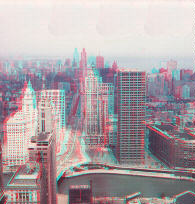
Chicago - 1968
(use red-blue
3D glasses / click for a 100Kb version)
*Our old products, the Model
#5h viewer (Brewster type for 5 inch cards) and sets
of viewcards to fit them are no longer available.. We've given many
views and viewers away --which seems a lot simpler, and just as "profitable"
:-)))

-
Monolithic Processing Might come back,
but it will have to be offered by others --sorry.
-
I have two major reasons:
-
* I'd like to focus on pursuing our own stereography.
-
* I found it too difficult to contend with scratches and
dirt on film emulsions. Possibly, film scanners with "ICE" scratch removal
technology works for stereo pairs --and someone with such a device will
step up to bat and make print pairs (like this one) --from our stereo formatted
35mm film.
.
-
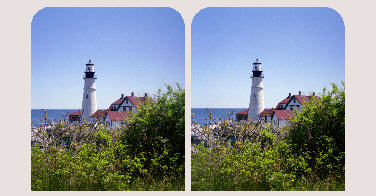
-
(view by Nancy Lee)
-
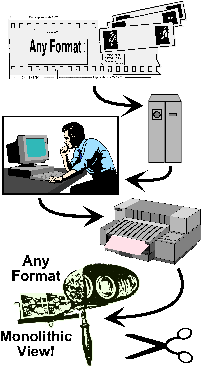 Dear
Stereographer: It's fairly simple to make your own
views --now that we have such excellent color printers, both as desk tops
and as digital commercial rigs in photo departments. My suggestions:
Dear
Stereographer: It's fairly simple to make your own
views --now that we have such excellent color printers, both as desk tops
and as digital commercial rigs in photo departments. My suggestions:
1) Write to me (with your SASE) for a free tutorial
CD on how to create your own print pair view cards, and consider joining
the Stereoscopic Society of America.
2) Have your digital finished work printed with a department
store Fuji or Kodak machine. Their outputs are as good as I ever achieved
in the color darkrooms I've built.
Office and home desktop printers tend to show some
"image structure" in the highlights --but are "good enough" for most of
our printing needs, and certainly for "free-view"
pairs. However, many photo quality desk top printers have become affordably
available (but watch the per print operating costs). We now use a
Brother brand "all in one" MFC-J985DW inkjet which promises penny/page
black and white, nickel a page color --and the image quality is great (using
premium papers). (This is break from my 27 year string of excellent HP
printers, due to high ink cartridge costs --and a lot of sassy screen messages
when I refilled cartridges.)
European "6x13 format" and American "free-view" pairs
on (about) 5 inch wide cards are something like 71% the image size of traditional
7 inch wide Holmes/Bates view cards. If you're going to use a 4x6 output
device (which is now about the only size available) you might wish to print
the entire ("monolithic") card that way, and have plenty of room to spare.
~~~--------~~~
*** Click
for our template patterns and trim/mount
steps. You'll need them for trimming/gluing print pairs to open cards (and/or
write for the latest tutorial on CD with your SASE.)
* If you're still using film,
please keep your film strips in clean sleeves.
The average shooter will be better
off when photography is all digital (check out the Fuji W-1 3D camera):
no dirt or scratches to permanently ruin your images. Peg and I still mainly
shoot digital now.
-----------------
 Digital
Comments: I suggest that you consider archiving non-Kodachrome
(E-14) color film to digital files on DVDs (more archival than compact
disks ("CDs"), provided you can find and afford a quality scanning service
(perhaps at Evergreen Film Service in Eugene). E-6 transparency and standard
color negative films (including Illford's XP2) have better life expectancies
than in the past, but 20 years is still likely to show some deterioration.
Digital
Comments: I suggest that you consider archiving non-Kodachrome
(E-14) color film to digital files on DVDs (more archival than compact
disks ("CDs"), provided you can find and afford a quality scanning service
(perhaps at Evergreen Film Service in Eugene). E-6 transparency and standard
color negative films (including Illford's XP2) have better life expectancies
than in the past, but 20 years is still likely to show some deterioration.
Many are unaware that most magnetic media, digital
and analog, is similarly rated (though I think it's more durable than commonly
thought).
The "good news" previously posted here --about CDs (like Kodachrome)
being rated to last 90 years --has become "inoperative". Now folks talk
about 15 to 30 years for good brands. :-((( However:
if you stay on your toes, you'll be able to "migrate" your image files
to whatever comes next. --Same goes for your digital camera images: archive
your files to DVDs (for now). (I don't know the archiviality of Blu-Ray,
but that technology may have arrived a bit too late on the scene.)

Accessories
for Nimslo cameras.
At this point my inventories of prepared lenses are
depleted.
For more information and for advice on making your own accessories
*-click!-*
-----------------------------
You might find the folding "6x13"
format viewers we and The Added
Dimension use to sell at American Paper Optics or at:
http://www.berezin.com/3d/
I no longer offer the "CedarEdge"
wooden stereoscope), nor the affordable
stereoscopes/viewers for 5 inch wide card print pairs.
 "6x13" loosely
refers to a pair of images that are each about 2-1/4" wide on a card that's
about 5" wide and often about 2.5" high. Alluded to is the 6x13 centimeters
of old European medium plate cameras and more recent paired "medium format"
frames from 6x6 and 6x7 format cameras --which frames are actually about
2-1/8" square. This range of format is also called "free
view" because it's easy to "spread" one's eyes and fuse the pairs without
benefit of an optical viewing device.
"6x13" loosely
refers to a pair of images that are each about 2-1/4" wide on a card that's
about 5" wide and often about 2.5" high. Alluded to is the 6x13 centimeters
of old European medium plate cameras and more recent paired "medium format"
frames from 6x6 and 6x7 format cameras --which frames are actually about
2-1/8" square. This range of format is also called "free
view" because it's easy to "spread" one's eyes and fuse the pairs without
benefit of an optical viewing device.
Obviously, affordable printing methods are challenged
to turn out the high resolution needed for stereoscopes, and this smaller
format is a bit more demanding. However, the results can be very pleasing,
as were the dozens of commercially printed projects I've been involved
with. Most of all, the gain in affordability, simplicity, and mailability
simply requires that we make this format work. See our Sets
page for this alternative.

If exchanging stereoscopic imaging samples
and ideas sounds interesting to you (either digitally or with traditional
photographic pairs), check into the NSA (http://www.stereoview.org/)
and SSA (http://www.ssa3d.org/). Costs
can be kept low in the photographic circuits by (say) simply "shifting"
a conventional camera to make stereo pairs (an SASE brings you instructions).
(There are modest NSA/SSA dues.)
And don't miss the International
Stereoscopic Union's web site at: http://wwwstereoscopy.com/isu

*Discover
MORE products, services, books, and other stereographica!
3D TV! (http://www.3dcompany.com/3dtvintro.html#TOP)
Visit the "3D Web"
(Bob Mannle's site + others)
Visit the Quellen
Company {you can get Q-VUs through http://www.berezin.com/3d/},
--which makes and supplies "Q-VU" mounts. They do for
print pairs what 35mm slide mounts do for transparencies. You order suitable
print pairs from a stereo format friendly processor, template trim them
(ask me for free instructions) and drop them in. Quellen also has mounts
and affordable plastic viewers for medium format ("6x13")
pairs. (Quentin's site provides some interesting medium format links.)
General Addresses
ADDRESSES FOR STEREOGRAPHERS
(out of date --sorry. Enclose a stamped self-addressed business
size envelope when requesting information.)
* American
Paper Optics, for all items formerly sold by The The
Added Dimension and many services in coöperation with "StereoType".
Also see http://www.berezin.com/3d/
* Berezin Stereo Photography Products / 21686 Abedul,
Mission Viejo, CA 92691. Berezin is our #1 supplier --of most everything.
Visit his web site at http://www.berezin.com/3d/*
to see his new products --including actual digital still and video 3D
cameras! (Check the reviews, however. These cameras have limitations.)
(949-215-1554,
fax: 581-3982)
* 3D from Dalia / PO Box 492 / Corte Madera,
CA -94976. Dalia Miller's catalogue is actually a proprietary magazine
that you subscribe to --filled with a wide range of quality antique and
rehabilitated equipment and media. (415-924-3356; fax: 6162)
* Studio 3-D (Ron Labbe) / 30 Glendale Street
/ Maynard, MA 01754. Format conversions, mounting, processing, and
projection services. - http://studio3d.com/
*Taylor Merchant Corporation / 5 Grayley Place
/ Huntington Stn. NY 11746212. Nice folding viewers for 5 inch card
format views, lenses for that and standard format stereoscopes. See:
http://www.stereopticon.com/
* Cygnus Graphics / PO Box 32461 / Phoenix, AZ 85064-2461.
My what great stuff!
* For the
exquisite wooden "SaturnScope" contact:
http://www.rmm3d.com/viewers/saturnscope.html
*Corner Rounder: Lassco Products, Inc. / 485 Hague
Street / Rochester, New York 14606 (716-235-1991).
Regular Stereo
Processing:
To the best of my knowledge,
we only have one choice for getting prints from negative film frames, but
it's a good choice. I'm currently having a discussion with Panda
Labs, which has been doing custom stereo printing for many years, to see
if they want to offer "standard deals" for our 35mm 5p and 4p formats.
Please stand by for more information: specifics and prices.
* Panda Labs
533 Warren Av. N
Seattle 98103
phone: 206-285-7091
http://pandalab.com/
This is a widely respected lab
which likes challenges and will print to/from custom formats and special
emulsions.
** If this is all too much trouble
and expense, consider buying a Fuji "W-1" or the Aiptek stereo camera systems,
going the synched cameras route (film or digital), or the Loreo 1-2-3 from
Berezin
--for which I've made some comments and suggestions per: digiprint/
* Four Star Photo of Georgia
Main Post Mini Mall Exchange
Fort Benning, GA 31905
As of 8-12-2010, their web site is down, the main phone number is disconnected,
the other one just rings, and the e-mail address I have for owner Richard
Maeher bounced.
* The Camera Shop of Klamath
Falls bought into a new photo processing system 5 years ago, but found
it too inflexible to allow of handling our 5p and 4p stereo formats.
* Grand Photo of St. Paul Minnesota
has a Better Business Bureau listing indicating that it's no longer owned
by Mark and Janet McCoy --even though the Grand Photo on-line presence
still suggests that, given encouragement, they might be willing to once
again try their hand at printing stereo pairs.
* www.digitaldreams3d.com/,
has
some very interesting services to offer, but the web site doesn't appear
to have been updated since Windows-95 days, their 877 number answers to
another business name, and I got an anonymous "leave message" using their
regular number. I'm waiting for any return on my e-mail ping.
This fellow offered the same kind of digital service
I tried to offer --plus he added interesting twists in being able to return
a variety of digital formats.
Other Services and Suppliers:
Lenticular: * Many who call and
write are seeking
lenticular processing for one of the many 2, 3, 4, and
5 lensed cameras that have been sold. Contact:
* http://snap3d.com/
(I worked with the owner-operator Peter Sinclair, nice guy :-)
* Q-Folder Mounts:Q-VU:
is a print pair mount which does for prints what slide mounts
do for transparencies. They're available in a variety of colors and styles.
Q-VU / 817 E. 8th Street / Holtville, CA 92250 at: http://www.qvu3d.com/,
and from suppliers like Berezin.
Stereoscopes:

* Doing business as the "Red Wing View Company", I
designed and made the original "split tongue" Red Wing Viewers. Later on
I supplied just the brass parts for Luther Askeland's
beautiful version. These two are all that remain and aren't for sale.
~~~~~~~~~~~~~~~~~~~~~~~~~~~~~~~~~~~~~~
"His principal income, it turned out, was from a line
of lovingly constructed replicas of the 19th-century stereoscopes that
provided entertainment in Victorian parlors along with the spread of photography
during the 1850s and 1860s. Invented in 1849, the stereoscope is a simple
mechanical device that allows two pictures taken from a slightly different
angle to be seen separately by each eye. Thus it produces the illusion
of three-dimensional depth, demonstrating how perception is shaped by the
angle of vision and the habits of the neural system. Luther sold them to
collectors throughout the country." --Rhoda R. Gilman: "Luther
Askeland and the Wordless Way"
~~~~~~~~~~~~~~~~~~~~~~~~~~~~~~~~~~~~~~
* A Photographer's
Place (use to be at: PO Box 274 / Prince Street Station
/ New York, NY 10012-0005), sadly, went out of business in 2001 --after
a long run as a treasured resource. See Bill
Pierce's goodbye. Among Harvey Zucker's expansive offerings of
books was a huge stock of reproduction ("litho") viewcards (I bought a
chunk of it) and the stereoscope I once resold as
"The CedarEdge":
 *
These 'scopes are still made by Don Claymore ("The Claymore Company", wholesale
only) out of finely finished and varnished hard and semi-hardwoods like
walnut and mahogany, which he saws and mills. He sells all that he and
his family can turn out, turning down huge orders (Toyo wanted 10,000)
so that he can remain hands-on. We're no longer offering these Standard
Holmes-Bates format stereoscopes, but they're widely available in gift
shops
and museums --for $100 to $150 retail, which includes a dozen litho reproduction
antique views. Here's
a recent story about Don, wife Shirley and family in the Delta County
Independent:
*
These 'scopes are still made by Don Claymore ("The Claymore Company", wholesale
only) out of finely finished and varnished hard and semi-hardwoods like
walnut and mahogany, which he saws and mills. He sells all that he and
his family can turn out, turning down huge orders (Toyo wanted 10,000)
so that he can remain hands-on. We're no longer offering these Standard
Holmes-Bates format stereoscopes, but they're widely available in gift
shops
and museums --for $100 to $150 retail, which includes a dozen litho reproduction
antique views. Here's
a recent story about Don, wife Shirley and family in the Delta County
Independent:
This stereoscope is/was available from Berezin Stereo
Photography Products (see:
http://www.berezin.com/3d/holmes.htm
At one point I had some input as to its geometry and
optics. The design turned out well. The CedarEdge comes with a good leather
hood, similar in eyewear accommodation and functionality to that used on
the old Red Wing Viewers. The Cedar Edges' large plastic lenses were good
in 10 out of the 10 last scopes which came through here.
* Alan Lewis makes/made the magnificent "MagniView
Orthostereoscopic stereoscope": a noseless, shorter focus tech 'scope
in an otherwise beautifully traditional wooden format. It has both inter-ocular
(optical centers distance) and vertical centerline adjustments. Short of
a Keystone-Mast ophthamological table scope, this is the best scope you
can buy (adjusted correctly). The stronger lenses work well, especially
with medium format transparency pairs, because they're achromats (color
corrected, to eliminate high contrast fringing).
~~~~~~~~~~~~~~~~~~
Stereoscope Design Considerations:
* The intended viewer geometry for classic (Holmes-Bates-Keystone-Society)
format 7 inch cards (by those who gave it any thought at all), used 200mm
(5 diopter), non-achromatic, plano-convex lenses with optical centers fixed
at 85mm to 89mm of separation. That geometry worked great. It still
does.
That optical centers dimension has very little to do
with the distance between your eyes, by the way. It's consequence is that
your eyes will usually "toe in" on an average view with its 76mm between
the frames (the "stereo window") and perhaps up to 79mm between details
in the images. That toe-in anticipates the tendency of people to "look
near" when they know a viewcard is less than a foot away. It also anticipates
that the average person will pull an interesting viewcard in as close as
he/she can comfortably focus, which proportionately reduces the effective
optical centers separation down toward the actual inter-pupilary distance
of your eyes --which averages 65mm.
Normal reading distance is about 14 inches (356mm)
--which is as close as a person (on average) cares to comfortably hold
a printed page. Eye-wise, that's about the same as pulling the stage-and-viewcard
in to a distance of only 5 inches --instead of the full 8" focal length
of a standard stereoscope's lenses. On average, the effective optical centers
of a standard stereoscope will be reduced (say) 87mm to 75mm, which also
happens to be the comfort limit, at which point your eyes' lines of sight
start having to everywhere diverge in order to fuse the two frames of an
old print pair stereograph.
* I don't believe that this stereo-optical geometry
was worked out by some founding genius of the stereoscopic industry. It's
rather the happy, serendipitous result of using the shortest practical
focal length lenses (out of deference to photographic resolution and chromatic
aberration), splitting a single lens into halves (and then squaring the
halves) to make a matched pair for a stereoscope, turning the thick sides
out, and placing them far enough apart such that most everyone's lines
of site are unimpeded as their eyes orbit across the visually fused pair
of a stereograph.
* If anything, modern (darkroom) photographic resolution
is a tad worse than were old contact printed, black and white viewcards
of the past. I've measured 10 line pairs per millimeter (once almost 14)
in good antique views, whereas my best color work (with a Rodenstock lens
at its f/5.6 sweet spot in a Beseller dichroic color head enlarger) ran
a film-to-print throughput of 6 to 8 line pairs per mm (up to 400 "DPI"),
which is twice the assumed resolution of a good larger format (8x10 inch,
say) photographic print. (This all works backward to assumptions about
a camera's smallest "circle of confusion" and a practical "depth-of-field"
to work with.) I therefore suggest that one stay with 8 inch (200mm, 5
diopter) strength lenses in a standard stereoscope, and no less than 6
inch lenses in a stereoscope or viewer meant for a 5 inch wide card (with
a European/Japanese type medium format print pair).
* Commercial, mass-produced antique viewcards were
die cut to fixed dimensions, therefore corresponding left-right points
in the distance ("homologous points at infinity") had to float apart when
close-up subject matter was included. Separation distances in such views
could reach well over 80mm, so the optical centers spacing of a standard
stereoscope is often needed --and with the card near full focal length.
~~~~~~~~~~~~~~~~~~~~~~~~~~~
Other Services:
* One of my former Stereosynthesis competitors (in
The Netherlands):
http://www.3d-conversion.eu/
~~~~~~~~~~~~~~~~~~~~~~~
Publications & groups
* Join the National Stereoscopic Assn. and read Stereo
World, a first class magazine. Visit the new NSA
web site. Learn all about stereoscopy and those doing it. Contact
the NSA at PO Box 14801, Columbus, OH 43214
* The Stereoscopic
Society, a correspondence association devoted
to the making and sharing of modern stereo images, is associated with the
NSA
(which you must first join).
The SSA has been circulating each other's print pair
views in the same format (along with other newer formats and media) for
over 100 years. A stereograph made in the 19th Century will fit into
and view nicely in a stereoscope made just a few years ago. Often we discuss
and debate the same subjects and techniques which concerned those early
members of what use to be called the SSAB: "Stereoscopic Society, American
Branch". Here's an old circuit entry of mine.
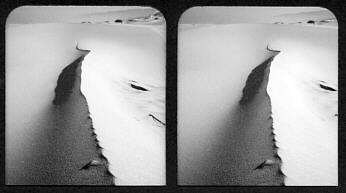
--and the verso, which carries the maker's comments
and any view data.
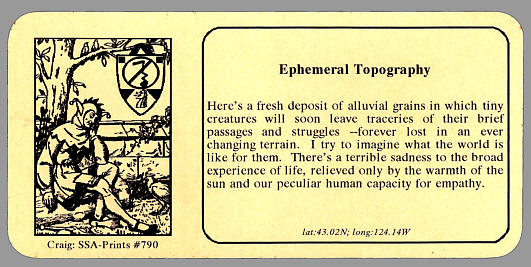
Circuit member comments (2 of 12), which are written on
the "sleeve"/envelope which holds each view card:
> "Quite pleasant to view. Your remarks make me
think you never owned a good dog!! --Sadness, Jaded." {Bill W.};
> "Wow! --what stereo does for this! I love it.
(Could be a moon of Jupiter.) I appreciate the sadness observation --one
has to ponder. Pleasure is for the moment (like viewing this stereo view)
--and the long range point, for us, seems to be the pointlessness. I see
no contradiction between Craig's comments and owning a good dog (or cat!).
They can and do co-exist. I do like this picture --what a philosophy initiator."
{Bill P.}
* You might also join the International
Stereoscopic Union and read their journal:
Stereoscopy.
* And then there's the mother of us all: Britain's
grand old Stereoscopic Society at:
http://www.StereoscopicSociety.org.uk
.--------------------------------.

-




![]()




![]()
![]()
![]()



 Dear
Stereographer: It's fairly simple to make your own
views --now that we have such excellent color printers, both as desk tops
and as digital commercial rigs in photo departments. My suggestions:
Dear
Stereographer: It's fairly simple to make your own
views --now that we have such excellent color printers, both as desk tops
and as digital commercial rigs in photo departments. My suggestions:
 Digital
Comments: I suggest that you consider archiving non-Kodachrome
(E-14) color film to digital files on DVDs (more archival than compact
disks ("CDs"), provided you can find and afford a quality scanning service
(perhaps at Evergreen Film Service in Eugene). E-6 transparency and standard
color negative films (including Illford's XP2) have better life expectancies
than in the past, but 20 years is still likely to show some deterioration.
Digital
Comments: I suggest that you consider archiving non-Kodachrome
(E-14) color film to digital files on DVDs (more archival than compact
disks ("CDs"), provided you can find and afford a quality scanning service
(perhaps at Evergreen Film Service in Eugene). E-6 transparency and standard
color negative films (including Illford's XP2) have better life expectancies
than in the past, but 20 years is still likely to show some deterioration.


